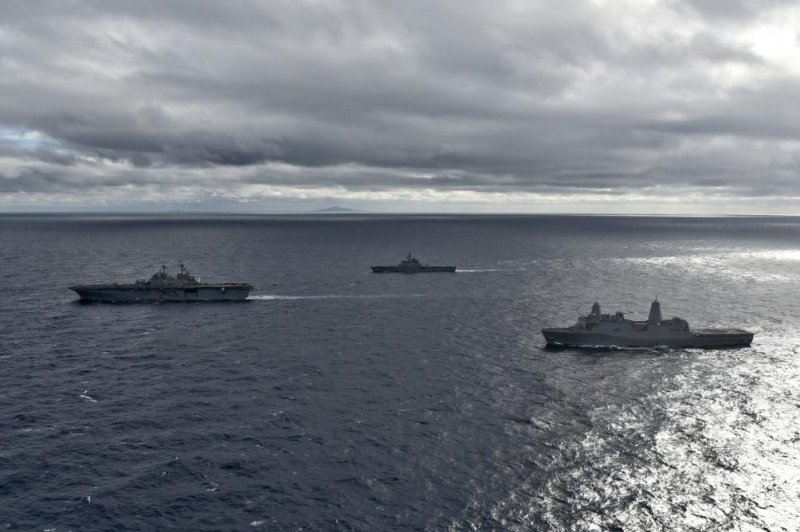The amphibious assault ship USS Wasp (L) the Japan Maritime Self-Defense Force amphibious transport dock ship Kunisaki (C) and the amphibious transport dock ship USS Green Bay participate in a cooperative deployment in the South China Sea. Photo by Mass Communication Specialist 1st Class Daniel Barker/
U.S. Navy
Jan. 15 (UPI) -- The United States and Japan conducted a joint two-day deployment in the South China for communication and maneuvering drills.
Participating Friday and Saturday were ships assigned to the U.S. Wasp Amphibious Ready Group and the Japan Maritime Self-Defense Force amphibious transport dock ship Kunisaki, the U.S. Navy said in a news release. The Wasp ARG has been deployed as part of U.S. 7th Fleet area of operations in support of security and stability in the Indo-Pacific region.
The U.S. ships include the USS Wasp, amphibious transport dock USS Green Bay and amphibious assault ship USS Ashland.
"We understood each other's radio calls very clearly, and they were very quick with their responses," said Operations Specialist 1st Class Jose Gonzales of the Amphibious Squadron, or PHIBRON 11, navigation assessor, said in a news release. "It was a routine operation just like working with another U.S. vessel."
Capt. Jim McGovern, commodore of PHIBRON 11, met with Kunisaki crew during a tour of the ship.
"It was a great opportunity to visit Kunisaki and see in person how well she and the ships of the Wasp ARG can operate together," McGovern said. "Our ability to work and train together with our JMSDF partners is a key enabler that ensures security and stability in the Indo-Pacific Region."
The U.S. Wasp departed Norfolk, Va., on Aug. 30, 2017, and arrived in Japan in January 2018. The ship is scheduled to return to Norfolk late this year, USNI News reported last month.
Seventh Fleet units typically take part in 100 bilateral and multilateral exercises and 200 port visits each year, according to the U.S. Navy. The region is 48 million square miles and includes 70-80 ships and submarines, 140 aircraft and approximately 40,000 Sailors and Marines.
On Monday, the leaders of the U.S. and Chinese navies discussed safe interactions and maritime operations during a meeting in Beijing. Adm. John Richardson, chief of Naval Operations, met with Vice Adm. Shen Jinlong, the commander of the People's Liberation Army Navy.
"They discussed professional interactions at sea, specifically addressing risk reduction and adherence to rules of behavior," according to a Navy release.
"Given the responsibilities that our navies have in the larger nation-to-nation relationship, we must work together," said Richardson, who made his second visit to China as the naval chief. "These meetings between senior leaders allow us to speak candidly about areas where we agree and about how to manage risk while we resolve our differences."















